9th-13th October
From what we've read, tales from friends and some limited prior experience, India - and Delhi in particular - can be a bit of a culture shock for the uninitiated. For that reason, starting off in the much more relaxed Kerala seemed like a good idea – it's more backpackers and beaches than the hot, sweaty crowds of the big Indian cities.
We arrived in late evening at Cochin International Airport to be faced with a conundrum:
The next morning we had a wander around town to get our bearings. Due to its location, Fort Kochi has been occupied by a the usual mix of sea-faring Europeans: in this case, the British, the Portuguese and the Dutch. The influence is obvious looking at the local architecture. The first thing we noticed however were the Chinese fishing nets - the iconic image of Kerala.
These huge counter-weighted nets require 4-5 people to operate them, but I suspect the ones in Fort Cochin are more for the tourists than fishing judging by the repeated entreaties from the operators to pose with them for photos.
Food-wise, we've probably eaten our last noodle: we’re now in India which means it's time for curry and its limitless variations. It’s slightly weird having curry every night (and some lunch-times) – in the UK, this kind of behaviour would be a fast-track to obesity – but things are different in India, in Kerala at least.
For a start, there’s much less meat. Most of the curries we've eaten have been vegetarian: amazingly fragrant dishes made with potato & cauliflower (aloo gobi), spinach & cheese (palak paneer), lentils (daal) and my favourite, chick pea curry (chana masala). Meat and fish is readily available, but partly because eating meat increases your chances of an upset stomach, and partly because the meat doesn't really add much to the flavour, we've mostly abstained. Having said that, being by the sea, we have had the occasional delicious fish curry.
Also, the food is much lighter: the rich, yoghurt and cream-based sauces are not as common here (more so in the north of India apparently) and there’s been no cases of our food turning up swimming in ghee. The breads (naans, rotis, etc.) are much thinner and lighter as well.
Having said all that, there’s little chance of losing any weight since everything is so delicious.
Ho hum.
We rounded off our stay in Fort Kochi with a trip to the theatre and a short performance of some Kathakali. I say 'short' because Kathakali plays can last for days and even the shortest stories can last for hours. Luckily, the Kathakali centre in Fort Kochi is geared-up for the tourists so the the performances are slightly briefer, but they do let you in early to see the amazing makeup being applied which can take as long as the show itself.
The play we saw – more of a scene really – told the story of a green-faced chap (clearly not to be trusted) trying to seduce some other chap's wife. He fails so tries to beat and rape her, but she escapes and tells hubby, who then kills him. It's much like the plot of any episode of Neighbours.
The actors tell the story entirely by facial expressions and complicated hand gestures. There’s also a narrator who sings the story to the audience with sound effects provided by a couple of drummers.
To be honest I'm not a huge theatre fan so I wasn't expecting much. The first 20 minutes – a demonstration of the basic skills, the hand movements and the facial expressions – brought to mind a constipated Kenneth Williams: not a promising start.
But when the action began in earnest, the music (the narrator singing over a harmonium drone), the drumming and the weirdly silent acting – all delivered with bucket-loads of conviction – combined to be strangely compelling.
It was very atmospheric: a hugely enjoyable and memorable couple of hours. A must-see if you're ever in Kerala.
Next up: a trip to the famed Keralan backwaters.
Current location: Varkala until tomorrow
Next stop: Trivandrum before flying to Delhi on Wednesday
From what we've read, tales from friends and some limited prior experience, India - and Delhi in particular - can be a bit of a culture shock for the uninitiated. For that reason, starting off in the much more relaxed Kerala seemed like a good idea – it's more backpackers and beaches than the hot, sweaty crowds of the big Indian cities.
We arrived in late evening at Cochin International Airport to be faced with a conundrum:
- The pre-paid taxi desk is inside the terminal building and only took rupees.
- We didn't have any rupees and the only ATM was outside the terminal.
- Once you leave the terminal, they don’t let you back in…
The next morning we had a wander around town to get our bearings. Due to its location, Fort Kochi has been occupied by a the usual mix of sea-faring Europeans: in this case, the British, the Portuguese and the Dutch. The influence is obvious looking at the local architecture. The first thing we noticed however were the Chinese fishing nets - the iconic image of Kerala.
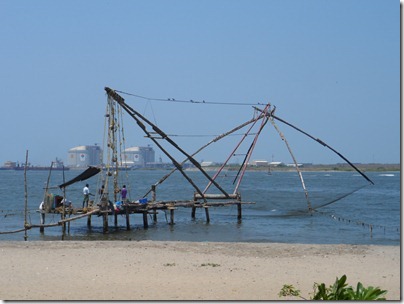 |
| Chinese fishing nets |
We had four days in town which is plenty of time to see everything. Although it’s part of a larger conurbation (Ernakulam), most of the sights are in and around Fort Kochi, and it’s not very big. In nearby Mattancherry we visited the Dutch palace – worth seeing for its murals and a good introduction to the history of the area – and the Jewish quarter with its old synagogue and maze of streets selling clothes and spices. We picked up some masala tea. In Fort Kochi itself there's the Santa Cruz Basilica and St. Francis’ church which houses the original, but now empty tomb of Portuguese explorer, Vasco da Gama.
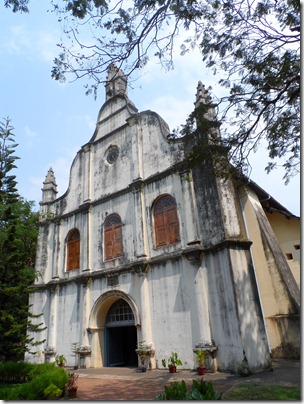 |
| St. Francis' church |
For a start, there’s much less meat. Most of the curries we've eaten have been vegetarian: amazingly fragrant dishes made with potato & cauliflower (aloo gobi), spinach & cheese (palak paneer), lentils (daal) and my favourite, chick pea curry (chana masala). Meat and fish is readily available, but partly because eating meat increases your chances of an upset stomach, and partly because the meat doesn't really add much to the flavour, we've mostly abstained. Having said that, being by the sea, we have had the occasional delicious fish curry.
Also, the food is much lighter: the rich, yoghurt and cream-based sauces are not as common here (more so in the north of India apparently) and there’s been no cases of our food turning up swimming in ghee. The breads (naans, rotis, etc.) are much thinner and lighter as well.
Having said all that, there’s little chance of losing any weight since everything is so delicious.
Ho hum.
We rounded off our stay in Fort Kochi with a trip to the theatre and a short performance of some Kathakali. I say 'short' because Kathakali plays can last for days and even the shortest stories can last for hours. Luckily, the Kathakali centre in Fort Kochi is geared-up for the tourists so the the performances are slightly briefer, but they do let you in early to see the amazing makeup being applied which can take as long as the show itself.
The play we saw – more of a scene really – told the story of a green-faced chap (clearly not to be trusted) trying to seduce some other chap's wife. He fails so tries to beat and rape her, but she escapes and tells hubby, who then kills him. It's much like the plot of any episode of Neighbours.
The actors tell the story entirely by facial expressions and complicated hand gestures. There’s also a narrator who sings the story to the audience with sound effects provided by a couple of drummers.
 |
| Putting on makeup |
 |
| All the colours are made naturally from stones and plants |
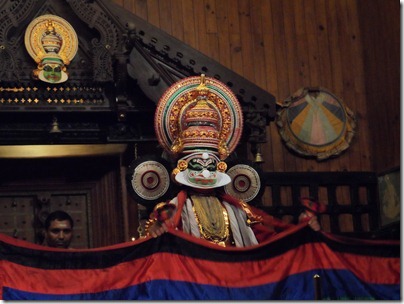 |
| Would you trust this man? |
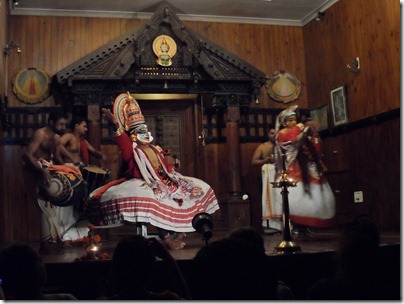 |
| Indecent proposal |
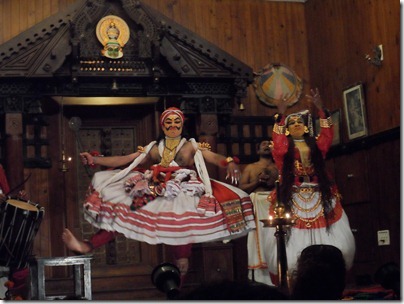 |
| All the parts are played by men by the way |
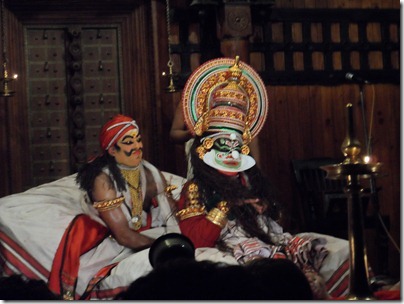 |
| "I have seen things you people would not believe..." |
But when the action began in earnest, the music (the narrator singing over a harmonium drone), the drumming and the weirdly silent acting – all delivered with bucket-loads of conviction – combined to be strangely compelling.
It was very atmospheric: a hugely enjoyable and memorable couple of hours. A must-see if you're ever in Kerala.
Next up: a trip to the famed Keralan backwaters.
Current location: Varkala until tomorrow
Next stop: Trivandrum before flying to Delhi on Wednesday
Did it remind you of Mama Mia ? ? ? ?
ReplyDeleteDid it remind you of Broadway and "Mama Mia" ?
ReplyDelete